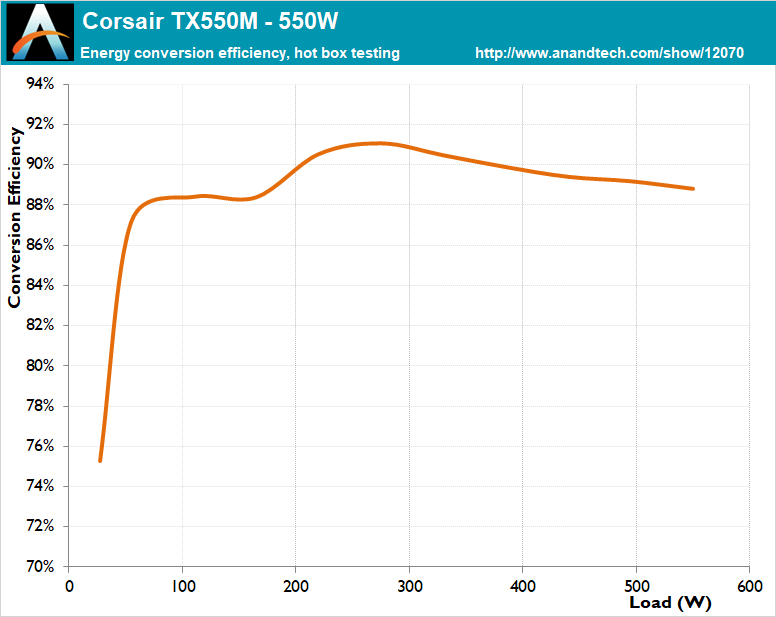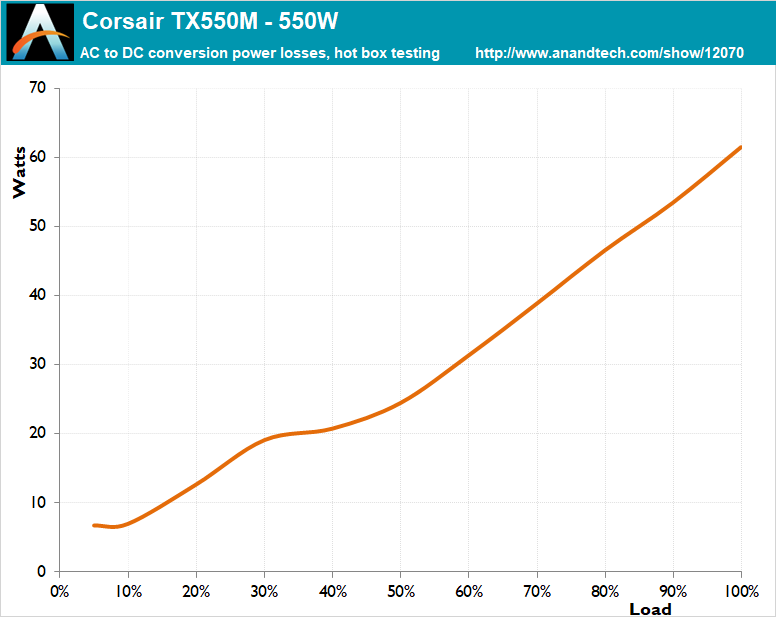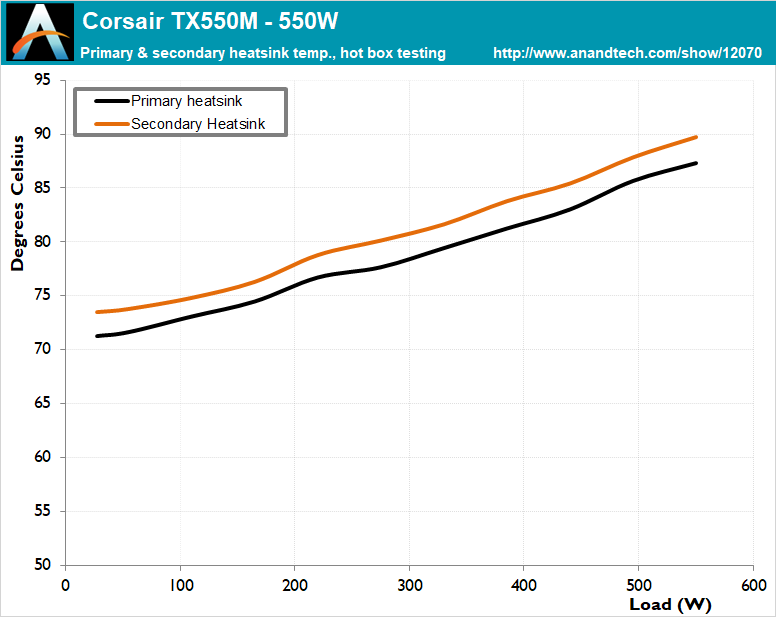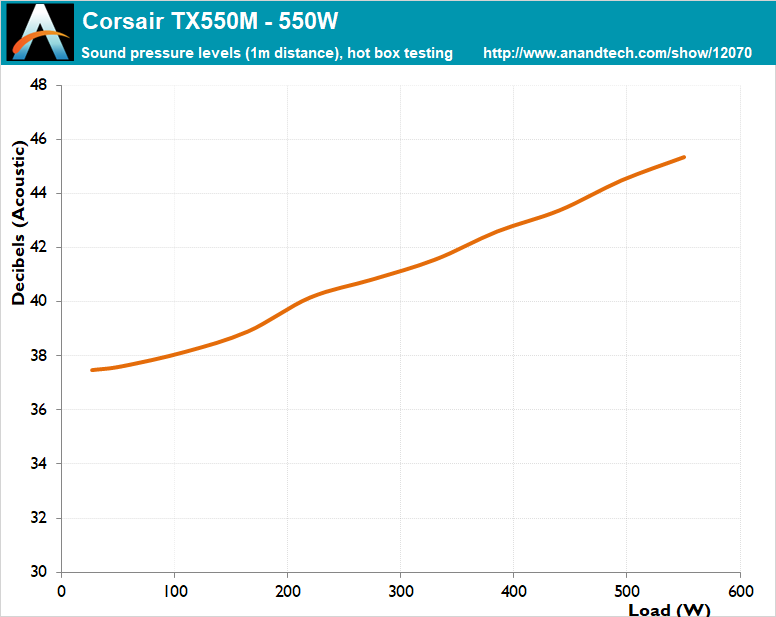The $80 Power Supply for Almost Everyone: The Corsair TX550M 80Plus Gold PSU Review
by E. Fylladitakis on December 1, 2017 8:00 AM EST- Posted in
- Cases/Cooling/PSUs
- Corsair
- PSUs
- 550W
- TX
- Modular
- Power Supply
Hot Test Results
We can see in the following tables that the electrical performance of the Corsair TX550M is very good for a mid-range PSU. Corsair definitely improved Great Wall’s designs vastly since our last encounter with them, increasing the efficiency and power quality of the platform. Although it does not impress, the maximum ripple of 36 mV on the 12V line under maximum load is a good power quality figure and satisfactory considering the price range of the PSU.
| Main Output | ||||||||
| Load (Watts) | 111.24 W | 277.4 W | 413.29 W | 549.67 W | ||||
| Load (Percent) | 20.22% | 50.44% | 75.14% | 99.94% | ||||
| Amperes | Volts | Amperes | Volts | Amperes | Volts | Amperes | Volts | |
| 3.3 V | 2.26 | 3.34 | 5.66 | 3.33 | 8.49 | 3.31 | 11.32 | 3.3 |
| 5 V | 1.81 | 5.08 | 4.53 | 5.07 | 6.79 | 5.02 | 9.06 | 5 |
| 12 V | 7.79 | 12.13 | 19.47 | 12.1 | 29.21 | 12.02 | 38.95 | 11.99 |
The TX550M appears to be a little sensitive to heavy cross-loading, with the maximum ripple on the 12V line jumping to 52 mV, but that still is a good performance figure under a highly unlikely usage scenario. The voltage regulation on every voltage line is between 1.2% and 1.4%, which is very good by today’s standards.
| Line | Regulation (20% to 100% load) |
Voltage Ripple (mV) | |||||
| 20% Load | 50% Load | 75% Load | 100% Load | CL1 12V |
CL2 3.3V + 5V |
||
| 3.3V | 1.4% | 16 | 16 | 18 | 22 | 16 | 20 |
| 5V | 1.5% | 20 | 20 | 22 | 24 | 18 | 24 |
| 12V | 1.2% | 22 | 26 | 30 | 36 | 52 | 34 |
High ambient temperatures have a measurable, but not excessive or unexpected, impact on the electrical performance of the Corsair TX550M.
The average nominal load range (20%-100%) efficiency drops by 0.7%, down to an average of 89.6%, when in a warm environment. This drop is evenly distributed across the load range, suggesting that there are no component quality or thermal stress issues. Note that the TX550M still is significantly more efficient when handling loads greater than 250 Watts.
The thermal control of the Corsair TX550M is simplistic, setting the speed of the fan mainly according to the internal temperature of the unit. Inside our hotbox, the high internal temperatures of the PSU force the fan to almost instantly reach an audible, yet typically comfortable noise level. From that point onwards, the speed of the fan is increasing almost linearly along with the load but, surprisingly, it does not ever reach painfully high noise levels. It will surely be loud at maximum load under such conditions, but we usually expect much higher noise levels from PSUs around this price range. Considering the very high ambient temperature, the internal temperature of the TX550M is good, although there definitely is room for improvement.















42 Comments
View All Comments
Kitsunemimi - Friday, December 1, 2017 - link
>People need reliability, not 3D graphics.Yeah, because all this "gaming" nonsense and those GeForce video cards are so dumb and pointless.
>long list of things people don't need [...] because of media hype, like [...] smart phones
I agree that the reason why effectively the entire mobile phone market has converted to smart phones within the span of a mere few years is none other than "media hype".
>cell phones
Are you high?
>3D video cards are expensive and energy wasting.
>people don't need [...] hybrid cars
What a joke.
wolfemane - Friday, December 1, 2017 - link
I own a hybrid for the simple fact I only have to stop at a pump once a month vs once a week. I didn’t get one for environmental reasons, social status, or media hype. I got one because my family needs a car and I’m sick of paying for gas. And before you get all high and mighty again, it cost no more than a similar size car with a similar package.DanNeely - Friday, December 1, 2017 - link
I'm not quite breakeven with the payment on my Accord hybrid at current prices/commute length; but probably will be after I move next summer (planning on a better but more distant location). Even if current prices/miles driven stay the same I'll break even about 1.5 years after my car's paid off and net $400/year afterwards. I kept my previous car for just under 11 years before something not worth the cost of fixing failed and forced a replacement (I was hoping for 2-3 more years out of it); so I should come out ahead by a good margin over the lifetime.Yuriman - Friday, December 1, 2017 - link
I picked up a used Insight around 4 years ago for 3 grand. Averaging between 65 and 85mpg, put 75,000 more miles on it with nothing but a set of tires and some oil changes. According to records I got from the previous owner, it's still on its 17 year old factory hybrid battery. From a value perspective it's hard to beat. Even compared with an economy car like a Civic or Corolla, this car has paid for itself in gas alone.New hybrids often don't have much premium over their non-hybrid counterparts, and seem to have, on average, better reliability, so I don't think the original comment holds any weight.
MrSpadge - Friday, December 1, 2017 - link
And I always wondered who's buying those low end Quadros. Have fun saving money with them over the "expensive 3D cards". Oh, and never use iGPUs - they have the 3Ds as well!AntonErtl - Friday, December 1, 2017 - link
Actually my PC without discrete graphics card (MSI Z170A-Pro, Core i5-6600K @4GHz, 16GB RAM, 3 SSDs, DVD drive) idles at 22W, and the peak power consumption I see is around 70W (still below the 20% point of its 400W PSU); and I measured the current into the PSU, i.e., these numbers include the PSU losses. I have a discrete graphics card lying around (Radeon 6770); the game I play runs nicely with the iGPU, though, so I did not put it in the box. With this card, the power consumption would be still less than 200W.hybrid2d4x4 - Friday, December 1, 2017 - link
"The optimal power range for a typical home entertainment/gaming system usually is within 400-600 Watts"Please stop regurgitating this kind of nonsense. The optimal range is as low as 120W for integrated video systems and up to ~300W for top-tier single card. There's the 1% that will overclock and/or run multiple vid cards, and these are the only people that will ever stress this kind of PSU to even 50%.
As a point of reference, my i5 4670, GTX1060, 4x4GB DDR3, 1 SATA SSD + 1 HDD system idles at 40W, and uses a peak of 220W measured at the wall. Typical gaming is 170-200W. I'm using a 400W Platinum PSU, and feel like this is a bit overkill for this system.
For a workstation with IGP, I would want a gold/plat 200W PSU, but nothing like this exists thanks to these articles normalizing the 500W-800W PSUs for normal consumers. Please stop it!
fred666 - Friday, December 1, 2017 - link
I agree.There is no reason to get more than 300-400W for the average user and this is including a stand alone video card and lots of peripherals. It's sad to see web sites such as Anandtech fall into the marketing BS of the power supplies makers.
t.s - Sunday, December 3, 2017 - link
average user using PC around 100-200Wsonny73n - Saturday, December 2, 2017 - link
I also agree.I fell for articles like this one and ended up with a 850W Corsair PSU. Even tho I OCed my i5 and my GPU, the power peak would never go above 380W.
Fool me twice, shame on me... Well, almost.